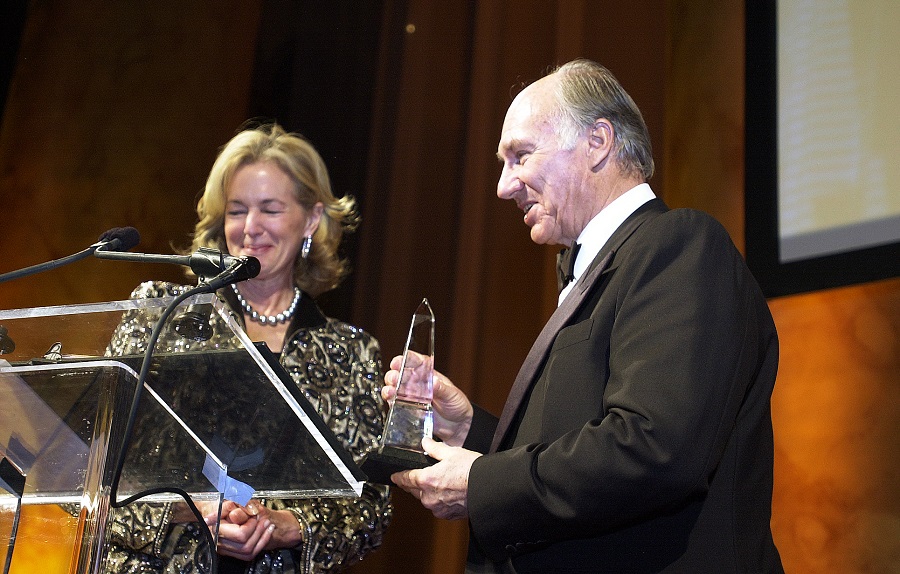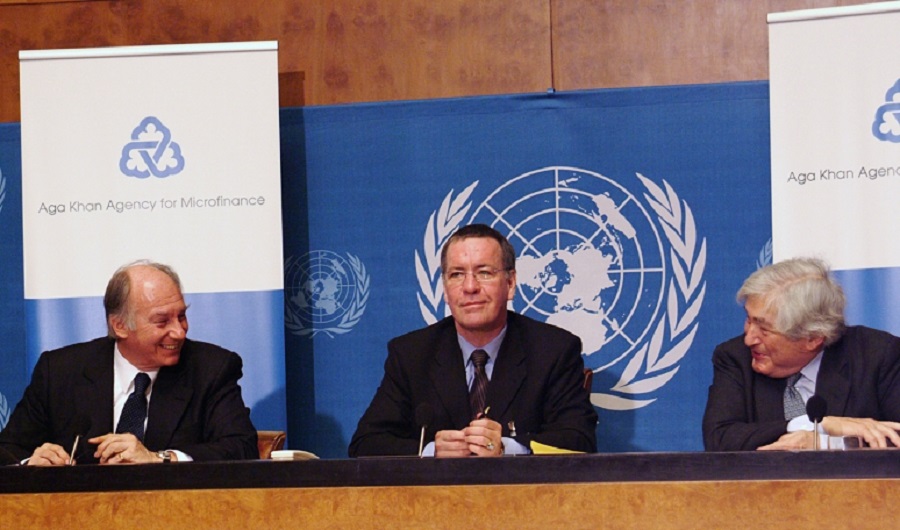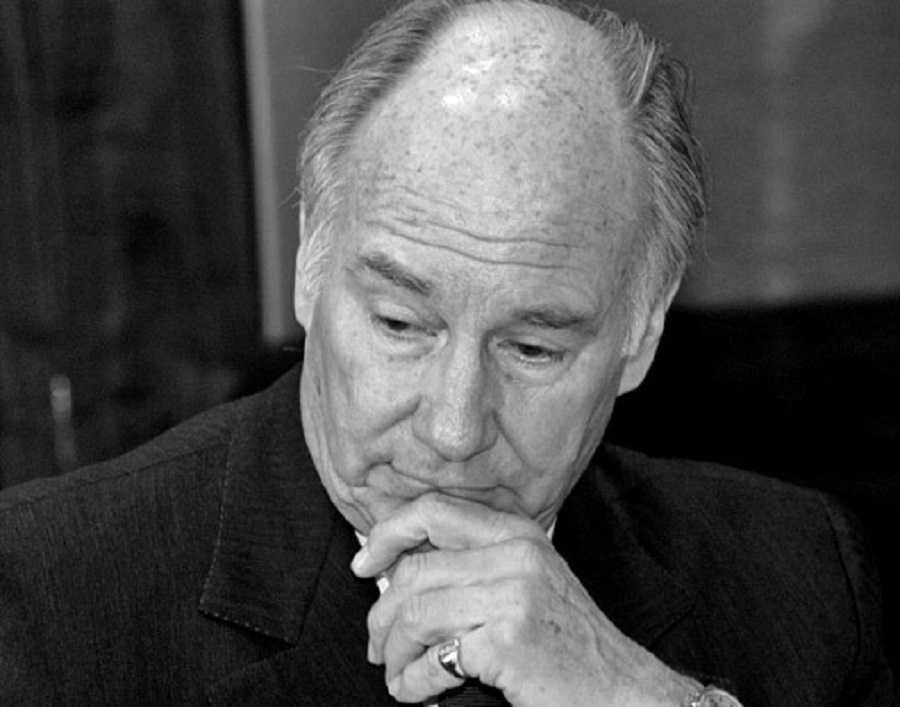A TRIBUTE BY JAMES WOLFENSOHN (d. November 2020)
WORLD BANK PRESIDENT (1995-2005)

James Wolfensohn, World Bank President (1995 – 2005), speaking on January 25, 2005 in Washington DC when the National Building Museum presented its sixth prestigious Vincent Scully Prize to His Highness the Aga Khan in recognition of his contributions to promoting design excellence and improving the built environment in the Muslim world.
Introduced by Abdulmalik Merchant
(Publisher/editor, Barakah.com)
On January 25, 2005, I was privileged to attend the award ceremony honouring Mawlana Hazar Imam, His Highness the Aga Khan, with the prestigious Vincent Scully Prize at the National Building Museum (NBM) in Washington, D.C.
As I arrived at the Great Hall, with its spectacular eight colossal Corinthian columns, I had a fortuitous meeting with Bruno Freschi, the renowned architect who designed the Ismaili Centre and Jamatkhana in Burnaby, Canada (1985). At the time, Freschi was based in the US capital, and I took the opportunity to introduce him to the then National President of Canada’s Aga Khan Council, Firoz Rasul, who was standing a few feet away with Fumihiko Maki, the iconic Japanese architect. This turned out to be the first encounter between the two celebrated architects. Maki went on to complete the Delegation of the Ismaili Imamat in Ottawa (2008) and the Aga Khan Museum in Toronto (2014).
The setting for the gala inside the majestic Grand Hall of the NBM grand was absolutely fabulous, with its spectacular structures. It was a most memorable evening for me that remains vivid to this day. I took detailed notes at the event, and upon returning to my hotel after the award ceremony, I prepared a lengthy description of the proceedings. A much shorter version was submitted for publication on the Ismaili Heritage website a few days later.

Subsequently, I began receiving distorted versions of speeches that were made that evening to honour the Aga Khan. I found inaccurate statements attributed to James Wolfensohn, the then World Bank President, who introduced the Aga Khan at the ceremony with a truly remarkable tribute. Unfortunately, after a brief hiatus, the embellished version of tribute is back in circulation – I received a copy only last week.
The tendency to recklessly forward emails without verifying the accuracy seems to continue. However, with the help of my detailed notes from 12 years earlier corroborated with the actual transcript on the NBM website – I can, hopefully, put the fake versions to rest for ever.
The authentic version of James Wolfensohn’s tribute to the Aga Khan is produced below.
His Highness the Aga Khan by James Wolfensohn
“….It is the extraordinary sense of humanity that he has. The great depth of real feeling for real people wherever they find themselves in society. He is a holy man. He is the leader of his faith. He’s a man who represents the very best in Islam.”

Your Highness, Ladies and Gentlemen:
“I’m here because I’m the leader of the groupies of the Aga Khan, not so much for his work in the built environment (although I must say to you that I am deeply impressed by all that he’s done) but by his work in the human environment. And it is in that context that I’m given a few minutes to pay tribute to him and to tell you something about him.
“In my 10 years at the bank, I’ve had the opportunity of meeting many people in the so-called development business. People that are concerned with the issues of poverty, people that in various ways display their interest in humanity, their concern for history, their concern for hope and for the future.
“And in that 10 years, I can tell you that there is one person who stands out in my mind as an icon of not only thought and philosophy but of action. And I have to say this in front of His Highness, that I don’t say this about everybody in the development business. He has truly done the most amazing job not only for the Ismaili community throughout the world, but really for all the communities that he serves.
(tribute continues after photo)

“He started The Aga Khan Development Network in 1967. It was his idea. And he has grown it in the most remarkable way, starting with the needs of education, dealing with all levels of education – from preschool education to particularly the education of women. He has looked through high schools, ordinary schools to universities. And I think many of you will know of the preeminence of The Aga Khan University in Pakistan, and the remarkable work that it has done in nursing, healthcare, management, and in everything that it touches.
(tribute continues after photo)
 The Aga Khan and Tanzanian President Benjamin Mkapa laying the foundation stone for the expansion of the Aga Khan Hospital, Dar-es-Salaam. Speaking on the occasion on March 18, 2005, the Aga Khan stated, “Unless we make significant investments in education as well as in new equipment and facilities, East Africa will fall behind in health care delivery.” This phase of the expansion resulted in five state-of- the-art operating theatres, a 12-bed intensive care unit, a radiology imaging department, new maternity facilities as well as an expanded pharmacy department. Photo: The Ismaili Canada, July 2005.
The Aga Khan and Tanzanian President Benjamin Mkapa laying the foundation stone for the expansion of the Aga Khan Hospital, Dar-es-Salaam. Speaking on the occasion on March 18, 2005, the Aga Khan stated, “Unless we make significant investments in education as well as in new equipment and facilities, East Africa will fall behind in health care delivery.” This phase of the expansion resulted in five state-of- the-art operating theatres, a 12-bed intensive care unit, a radiology imaging department, new maternity facilities as well as an expanded pharmacy department. Photo: The Ismaili Canada, July 2005.
“Now he has expanded that into Tanzania and into other parts of Africa where he’s also set up recently The Aga Khan Hospital – I learned this only tonight – the first teaching hospital in East Africa which is giving Aga Khan University degrees. But even beyond that, when we were talking a couple of years ago about the work that we have done in information technology, His Highness said to me, “Well, we’re going to set up a university in the mountains in Tajikistan to serve Kazakhstan and Kyrgyzstan because these are high mountainous areas. And we are going to teach through internet and through using information technology, because people can’t move around. And so we’ll set up a university on top of a mountain.” And already he is providing courses in those areas, working with governments and with officials to strengthen capacity in terms of management.
“His work in health is legendary as is his work in education. And he also does it in a remarkable way, in that The Aga Khan Fund for Economic Development (which is another invention of his) deals with getting the private sector involved in income-producing projects that allow for the creation of work and for the profitable use of investment in the countries that he serves.
(tribute continues after photo)
 The inset photo shows Kyrgyz Prime Minister, Sooronbay Jeenbekov, and the Aga Khan unveiling the plaque on October 19, 2016 to officially inaugurate the Naryn Campus, the first of 3 campuses, of the University of Central Asia (UCA). The University has been created by the Governments of Kazakhstan, the Kyrgyz Republic, Tajikistan, and the Aga Khan Development Network (AKDN) to be a catalyst for social and economic development in the region’s mountain societies. The Naryn Campus is to be followed by the construction of campuses in Khorog, Tajikistan (2017) and in Tekeli, Kazakhstan (2019). The undergraduates who joined the inaugural class in Naryn earned a seat through a competitive, merit-based and needs-blind admissions process and come from urban centres, secondary cities and small villages across the Kyrgyz Republic, Tajikistan, Kazakhstan, Pakistan and Afghanistan. Nearly 40 per cent of the first 71 students who joined are women. Photo: AKDN/Gary Otte.
The inset photo shows Kyrgyz Prime Minister, Sooronbay Jeenbekov, and the Aga Khan unveiling the plaque on October 19, 2016 to officially inaugurate the Naryn Campus, the first of 3 campuses, of the University of Central Asia (UCA). The University has been created by the Governments of Kazakhstan, the Kyrgyz Republic, Tajikistan, and the Aga Khan Development Network (AKDN) to be a catalyst for social and economic development in the region’s mountain societies. The Naryn Campus is to be followed by the construction of campuses in Khorog, Tajikistan (2017) and in Tekeli, Kazakhstan (2019). The undergraduates who joined the inaugural class in Naryn earned a seat through a competitive, merit-based and needs-blind admissions process and come from urban centres, secondary cities and small villages across the Kyrgyz Republic, Tajikistan, Kazakhstan, Pakistan and Afghanistan. Nearly 40 per cent of the first 71 students who joined are women. Photo: AKDN/Gary Otte.
“I have never met anybody who not only has the vision, but who has the personal management capacity to be able to take these visions and realize them. And I have to say that as someone who is in the professional field, he has a wonderful way of doing it, which perhaps gives him an advantage over most of the rest of us, in that he draws on remarkable experts, but he makes the decisions. I have dreamed of that at the World Bank. And so when I look at him, I not only admire him but I envy him terribly in the way in which he can operate and, indeed, bring to an effective end the work that he’s doing.
“And through it all, having seen him in many, many parts of the world, and having talked to him at length on many subjects, there is one thing which distinguishes him, which is not in the buildings and not in the organization. It is the extraordinary sense of humanity that he has. The great depth of real feeling for real people wherever they find themselves in society. He is a holy man. He is the leader of his faith. He’s a man who represents the very best in Islam. Something that all too often we tend to forget these days. That Islam carries with it values and a culture from which we can all learn. And so it is especially wonderful tonight that he’s being honoured with this prize for the built environment at a time that we’re also thinking of the work that he’s done at the human level and, indeed, the level of faith and morality which he does so remarkably well….We salute you, Your Highness.”
 The Aga Khan pictured during a panel discussion on “Design in the Islamic World and Its Impact Beyond”, held at the National Building Museum on January 26, 2005, the day after the Vincent Scully Award ceremony. Photo: Vivian Rozsa, Washington D.C.
The Aga Khan pictured during a panel discussion on “Design in the Islamic World and Its Impact Beyond”, held at the National Building Museum on January 26, 2005, the day after the Vincent Scully Award ceremony. Photo: Vivian Rozsa, Washington D.C.
Date posted: February 24, 2017.
Last updated: August 25, 2022.
____________
For links to all the posts in this special project on His Highness the Aga Khan, please see the drop down menu bar at top of this page or click on Table of Contents. Also join/like Barakah’s faceboook page http://www.facebook.com/1000fold.
Barakah welcomes your feedback. Please complete the LEAVE A REPLY form below or send your comment to simerg@aol.com. Your letter may be edited for length and brevity, and is subject to moderation. You may choose to remain anonymous. Please note that we never show your email address when we publish your comment, and don’t share it with others without your express written permission.
____________

James Wolfensohn (1933-2020) served with enormous distinction as President of the World Bank for ten years from 1995-2005. Untiring in his commitment to better understand the challenges facing bank member countries, he traveled to countries around the world meeting with the bank’s government clients and representatives from every walk of life. The result of this extraordinary commitment placed the bank at the forefront of addressing global challenges including primary education, basic health, HIV AIDS programs, the environment and biodiversity. Described as a Renaissance man, Wolfensohn served as Chairman of Carnegie Hall in New York during the 1980s, and then became chairman of the John F. Kennedy Center for the Performing Arts, serving in that capacity for six years until his appointment as president of the World Bank.
______________
The above piece includes textual material from the websites of the National Building Museum, and the Aga Khan Development Network.
Thank you and may Mawla bless you for your excellent work that I can share with my many Canadian friends who know and admire Hazar Imam.
LikeLike
Malik, thank you so much for sharing this article with us. It gives immense joy and happines to hear how Maula Bapa has devoted his entire life for the betterment of Ismailis and the world at large.
LikeLike
Indeed, the Aga khan serves the world with integrity, devotion and responsibility and represents the actions of a true Muslim leader. We are very lucky indeed to have a living Imam leading us throughout our lives. Muslims everywhere need to follow his foot steps to make this world a better and most beautiful place to live, and to leave the world a safe, awesome and better place for the generations coming after us. Let us s build bridges across communities, cultures and beliefs. We must respect and value diversity which is the beauty of every aspect of our lives. Thank you.
LikeLike
We always find something good and refreshing to see and observe that we as Muslims have personality and Imam like Aga Khan. May he live a long and happy life. Ameen.
LikeLike
Thank you for sharing this wonderful and honest tribute to our beloved Mawlana Hazar Imam who is tirelessly sacrificing his life for the common good of humanity in various parts of the world. This is exhilarating!
LikeLike
[…] via The Aga Khan Stands Out as an Icon of Action — Barakah […]
LikeLike
What a privilege to be an Ismaili when you hear this kind of tribute for Mawla Bapa!
LikeLike
Thank you for sharing.
LikeLike
Thank you for this excellent article.
LikeLike
Thanks Malik for sharing the article with the public. You are doing a great service in publicizing Ismaili events and especially about Hazar Imam’s immense contribution to humanity. Keep it up. Regards. Mansoor.
LikeLike
Thank you Malik for the excellent tribute to His Highness the Aga Khan.
LikeLike
Thank you for sharing this tribute with an introduction. The piece clarifies what was actually said at the Vincent Scully Award Ceremony by Mr. Wolfensohn. I am deeply grateful to your commitment to get the correct tribute circulated as widely as possible.
LikeLike